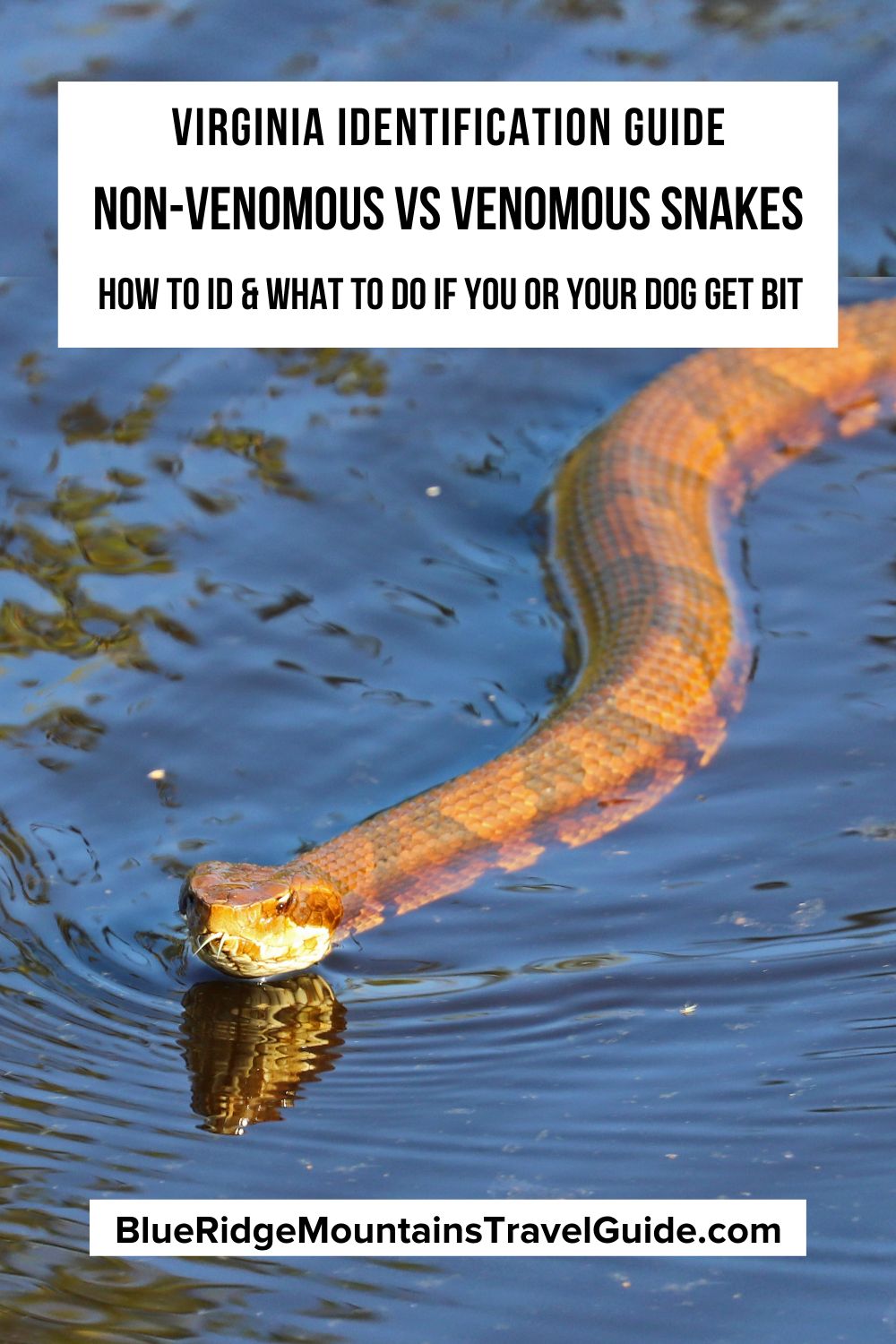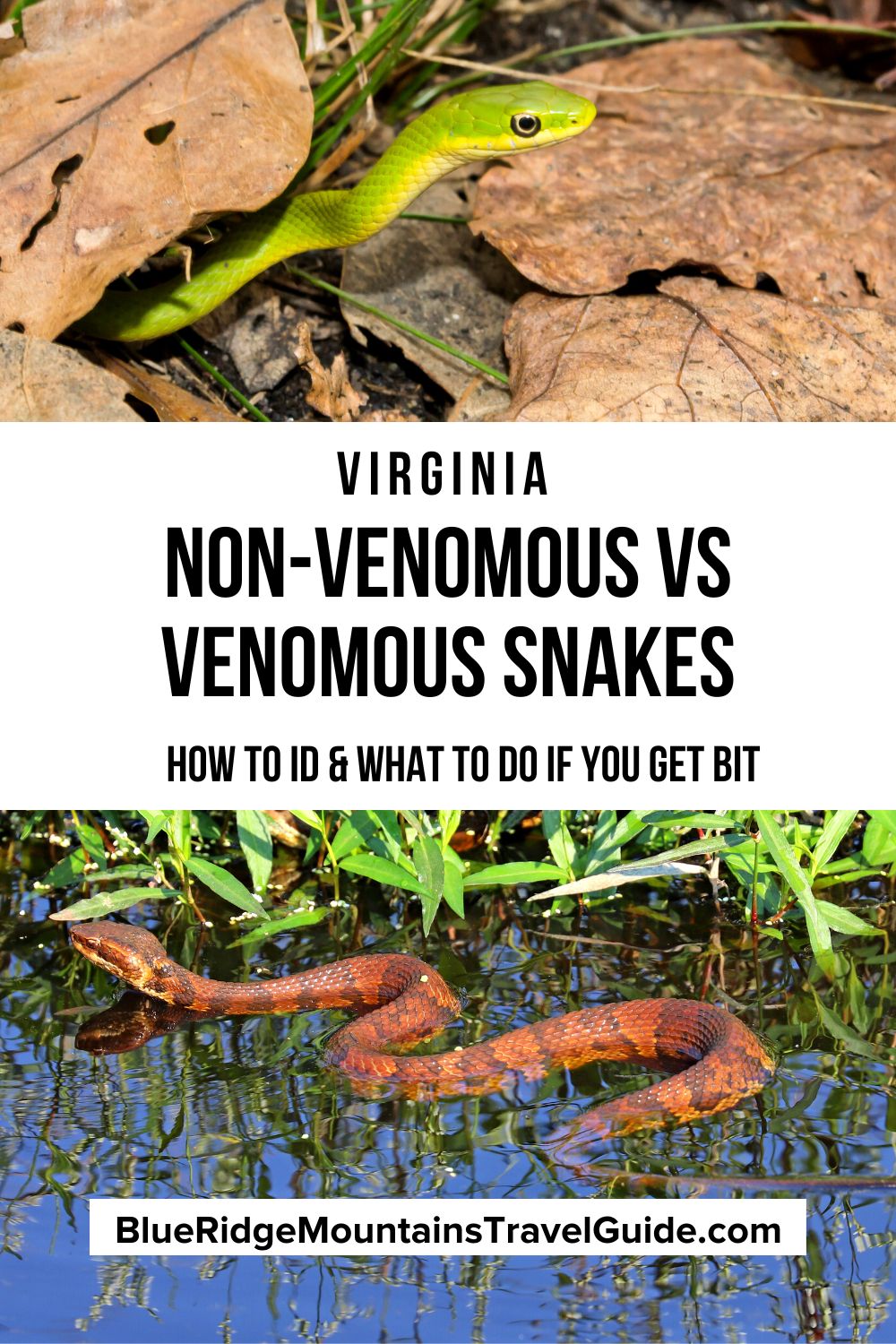For many people, the snakes in Virginia all warrant a fright. And there’s no collection of rational facts and figures that can make them feel differently.
In their eyes, snakes are snakes, and all of them are considered “armed and dangerous.”
Unfortunately, this narrow mindset often culminates in a dead snake– a sad outcome that happens far more frequently than an actual snakebite.
On the other hand, serious camping and hiking enthusiasts may have the opposite reaction, so elated at the sight of a snake that they get too close in hopes of photographing or simply seeing it up close.
In reality, approaching a snake (whether venomous or not) usually agitates it. Not only is this uncomfortable for the snake, but it’s also potentially bad for the person getting closer to the irritated snake.
If you see a snake in the wilderness, the right move is something in between these extremes: Stay cautious and distant, but take the time to appreciate an amazing animal encounter.
There are 31 species of native Virginia snakes, so it’s possible that spending a good bit of time in the forests of VA will lead to a snake sighting.
Read on for our in-depth guide to non-venomous vs venomous snakes in Virginia, including details on how to tell her the species apart.
READ MORE: The 10 Best Hikes on the Appalachian Trail in VA

Virginia Snake Identification: Non-Venomous vs. Venomous
Of the 31 types of snakes found in the state, there are only three species of venomous snakes in Virginia: Cottonmouths/Water Moccasins, Copperheads, and Timber Rattlesnakes.
That being said, some non-venomous snakes are easily mistaken as “poisonous” snakes of Virginia.
Case in point: There are four species of water snakes in Virginia, only one of which is venomous. However, the harmless Northern Water Snake and Brown Water Snake are often mistaken for the venomous Water Moccasin.
They all look very similar, with heavy bodies and comparable markings. And they behave similarly, such as flattening their bodies, emitting musk, and striking when threatened.
In other words, it’s best to just steer clear when it comes to the Virginia water snakes, particularly in the southeastern regions of the state.
Eastern Hog-nosed Snakes, Eastern Milk Snakes, baby Black Racers, and other snakes all get mistaken for venomous Copperheads from time to time.
Though none of these have the distinctive copper head, they do have similar patterning. However, the comparisons between these species usually stop there.
Then there’s the Timber Rattler, the only species on the list of rattlesnakes in Virginia. The Eastern Hognose and Eastern Milk Snake sometimes are confused with Timber Rattlers because they mimic rattlesnakes as a means of defense.
Lastly, Virginia is not home to any Coral Snakes. But it does have Northern Scarlet Snakes, Scarlet Kingsnakes, and Eastern Milk Snakes, which are all commonly mistaken for Coral Snakes.
READ MORE: The 15 Best Lakes in the Virginia Mountains to Visit
3 Venomous Snakes Native to Virginia

1. Eastern Copperhead
Agkistrodon contortrix
By far the most commonly found venomous snake in Virginia is the Eastern Copperhead. This species is present in nearly every county in the Commonwealth of VA.
Copperheads are pit vipers, so they have triangular-shaped heads, as well as thick bodies. Of course, they also have copper-colored heads, and juveniles also have flashy yellow tails they tend to use as lures.
Copperheads can grow up to four feet long, but most tend to top out at around three feet. They have brown hourglass markings (which some say look like Hershey’s Kisses) over a lighter tan background.
These snakes tend to stay in the forest, and they blend in very well amongst the leaf litter. Incidents with Copperheads usually occur because they accidentally get stepped on.
Copperheads feed primarily on mice, frogs, and insects, and they ambush their prey.
READ MORE: The 10 Best Virginia State Parks in the Blue Ridge Mountains

2. Northern Cottonmouth
Agkistrodon piscivorus
Cottonmouth snakes in Virginia are only found in the southeastern corner of the state, where the weather tends to stay much warmer.
So they aren’t really a concern for those visiting the Blue Ridge Mountains or the Shenandoah Valley.
Cottonmouths are pit vipers that can grow up to six feet long. They have heavy bodies and triangular heads, and they spend most of their time in or around water (semi-aquatic), especially creeks and lakes.
Water Moccasins are also known as cottonmouths due to the white inside their mouths, which they display when threatened. They also flatten their bodies and emit a stinky musk.
These snakes eat everything from frogs and fish to rodents and even other snakes.
READ MORE:The 10 Best Things to Do in Staunton VA
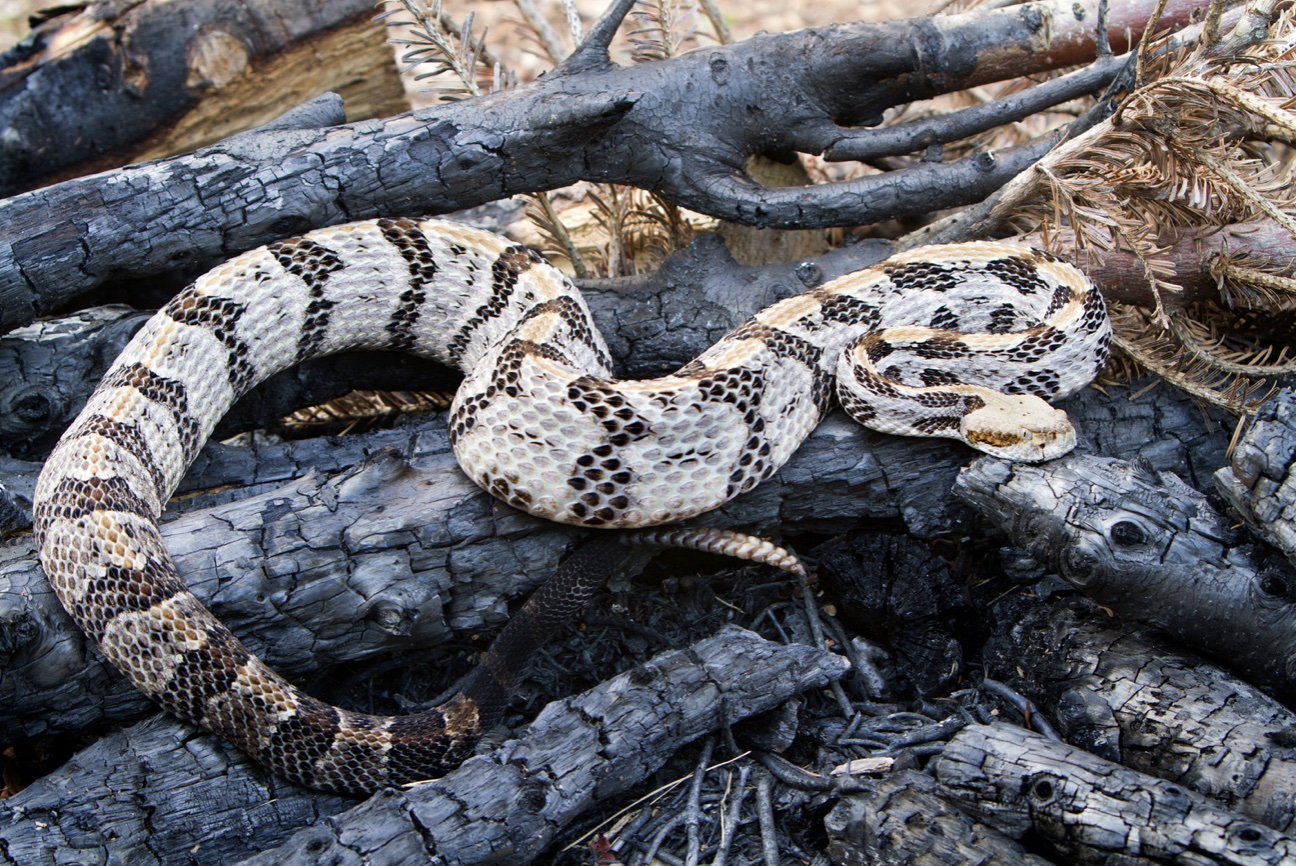
3. Timber Rattlesnake
Crotalus horridus
The Timber Rattler is the only rattlesnake native to Virginia, and it’s mostly found in the mountains in the western and northern parts of the state.
There are a few counties in the far southeastern corner that also get this snake, which is often called a Canebrake Rattlesnake in lower elevations.
Timber Rattlesnakes can stretch up to 6 feet long and have black chevrons across their back, which have a background coloring that varies from dark gray to orange-brown.
They’re normally a very shy snake, so most encounters with the Timber Rattler occur in late summer, at the height of their mating season.
They feed primarily on rodents.
READ MORE: The 10 Best Things to Do in Luray VA
8 Common Non-Venomous Snakes in Virginia

1. Eastern Worm Snake
Carphophis amoenus amoenus
As its name suggests, the Eastern Worm Snake is quite small and looks rather worm-like.
It also spends most of its time burrowed in the ground, where, ironically, it actually eats worms.
Worms Snakes are typically less than a foot long. They’re two-toned, with solid brown on their backs and pink on their bellies.
They likely won’t be seen out and about, but they can be a fairly common find under logs, rocks, and similar objects.
READ MORE: The 20 Most Beautiful Wildflowers in Virginia (& Where to See Them)
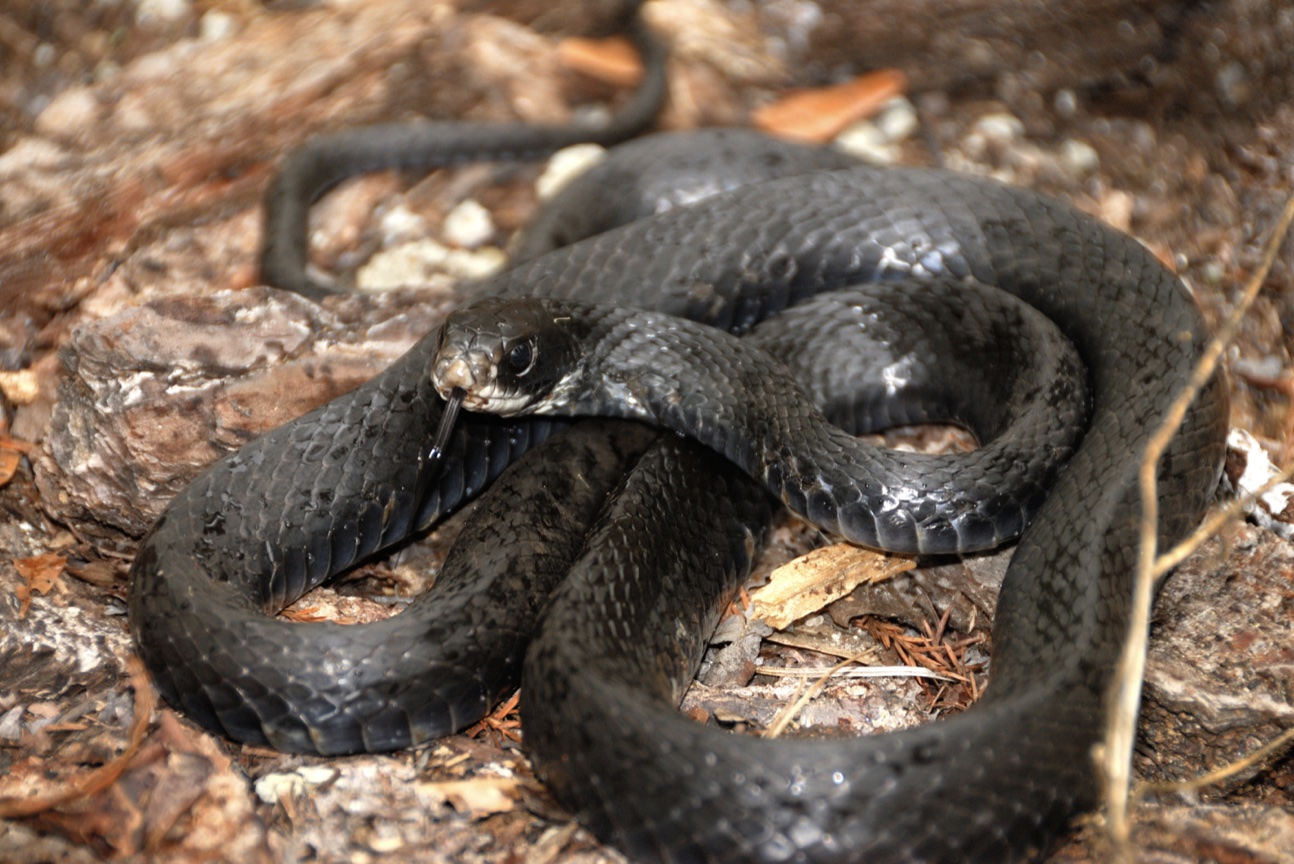
2. Northern Black Racer
Coluber constrictor constrictor
Black Racers are speedy critters that typically grow to be 3 to 5 feet long, with the record in Virginia reaching nearly 7 feet.
These can be easily confused with adult Rat Snakes (which are also called Black Snakes in Virginia), but they aren’t white on the bottom and don’t get quite as large.
Nevertheless, the Black Racer is a constrictor, and it is happy eating just about anything, including Junebugs, small birds, eggs, other snakes, shrews, lizards, flying squirrels…
Black Racers like grassy areas, but they can also be found in open woodlands near grassy areas.
READ MORE: The 10 Best Virginia State Parks in the Blue Ridge Mountains
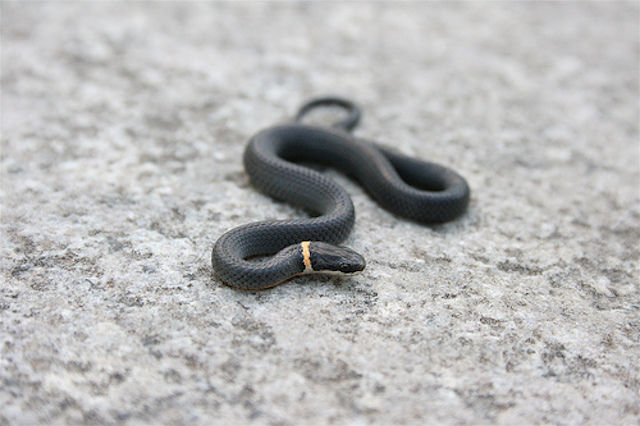
3. Northern Ring-necked Snake
Diadophis punctatus edwardsii
Ring-necked Snakes are quite small, barely over a foot long, and thin.
They are primarily characterized by a light, cream-colored ring around their neck.
Otherwise, the Ring-necked Snake is somewhat plain, with a bluish-black (possibly gray or brown) body and a white chin.
These are shy snakes that typically nestle into leaf litter, or beneath logs or rocks. They feed on small animals like earthworms, salamanders, and skinks.
READ MORE: The 15 Best Things to Do in Roanoke VA
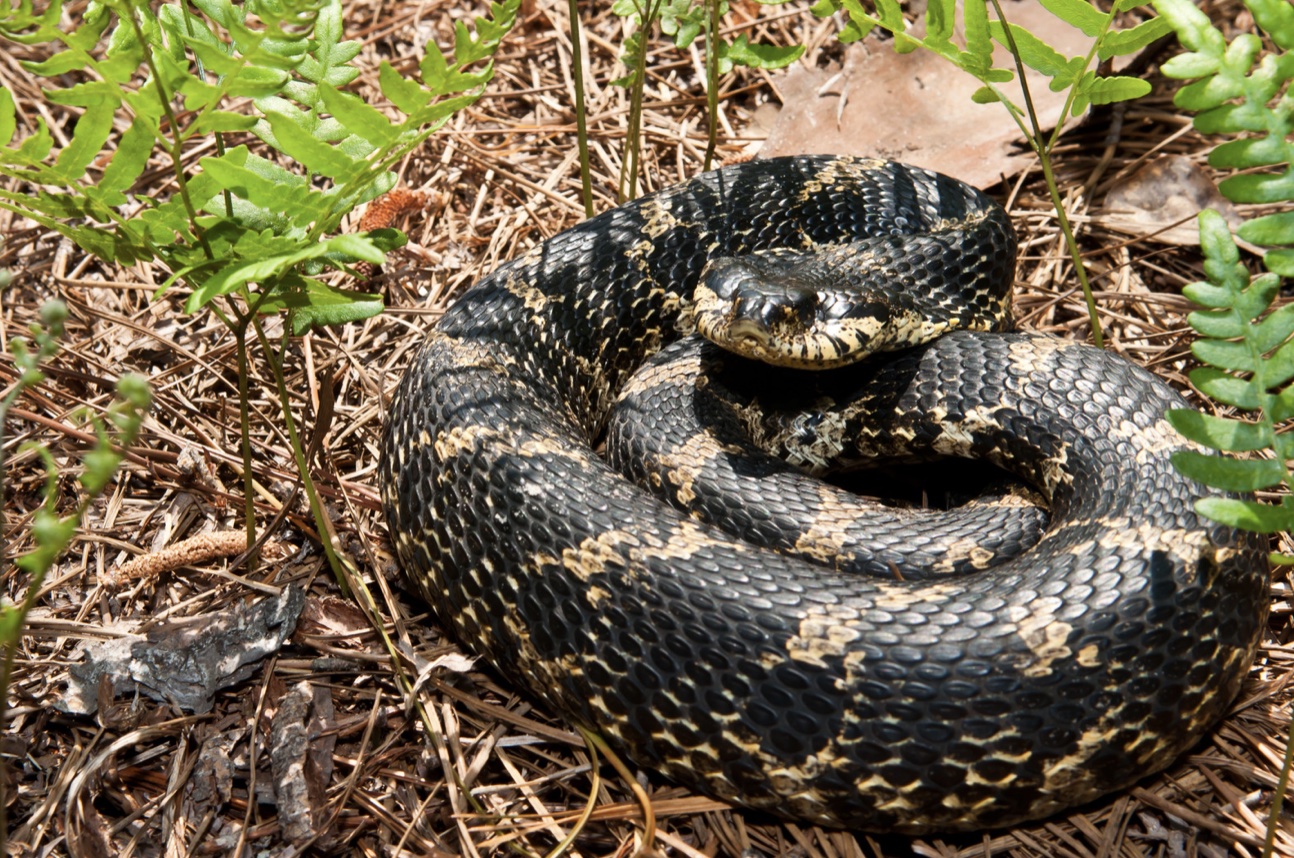
4. Eastern Hog-nosed Snake
Heterdon platirhinos
Eastern Hog-nosed Snakes are short and stocky, and they have some truly weird animal characteristics.
When threatened, they’ll often flatten their neck out like a cobra, hiss, and tried to scare off the intruder.
If they strike, they’ll probably do so repeatedly.
But they’ll just as often play dead, rolling over onto their back like a possum!
Eastern Hog-nosed Snakes eat frogs and toads with another bizarre behavior: They use large teeth at the back of their mouths to pop the amphibians open before swallowing.
READ MORE: The 15 Best Things to Do in Lexington VA & Natural Bridge VA
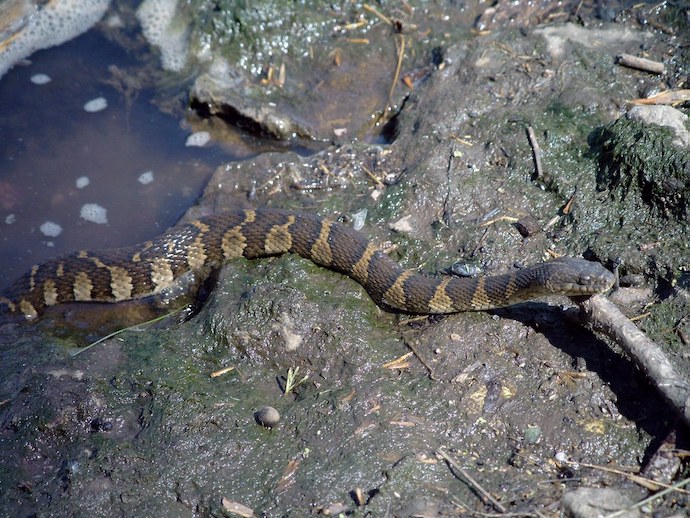
5. Northern Water Snake
Nerodia sipedon
Outside of the southeastern counties of Virginia, most water snakes you see are going to be harmless Northern Water Sakes, which are a fairly common sighting.
They get quite large, with heavy bodies that can reach 5 feet long. They tend to be dark, with colors that range from black to brown, gray, and/or red.
This beautiful snake is easily (and reasonably) mistaken for the Cottonmouth Water Moccasin.
We’ve seen them sunning themselves on rocks near numerous creeks, rivers, and waterfalls.
They feed on a wide variety of prey, but they’re especially partial to fish and amphibians.
READ MORE: 10 Great Romantic Getaways in Virginia for Couples
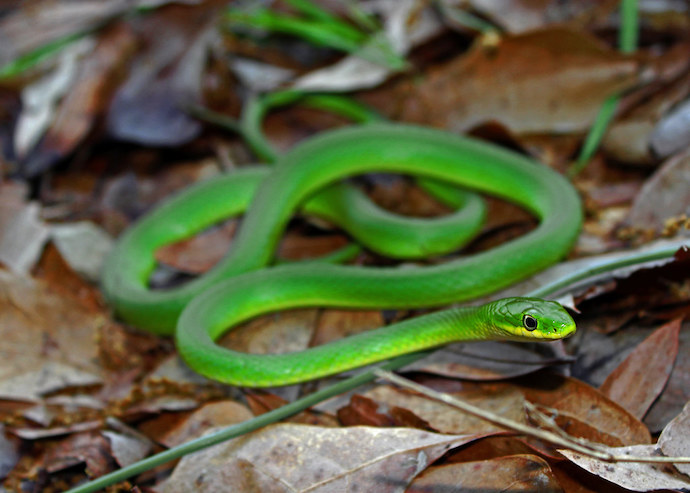
6. Northern Rough Green Snake
Opheodrys aestivus aestivus
Sleek, swift, and green, the Rough Green Snake is found in over 75% of the counties in Virginia, with the exception of a few high-altitude spots.
They can grow up to 3 feet long, and have slender bodies. They have vibrant green backs, with creamy yellow underbellies.
Northern Rough Green Snakes are arboreal, mostly living in the forest, but they’re sometimes found in the water and in the suburbs.
They feed exclusively on invertebrates, such as grasshoppers, snails, wasps, and caterpillars. They’re often eaten by birds, domestic cats, and lawnmowers.
READ MORE: The 10 Best Things to Do in Waynesboro VA (Augusta County)
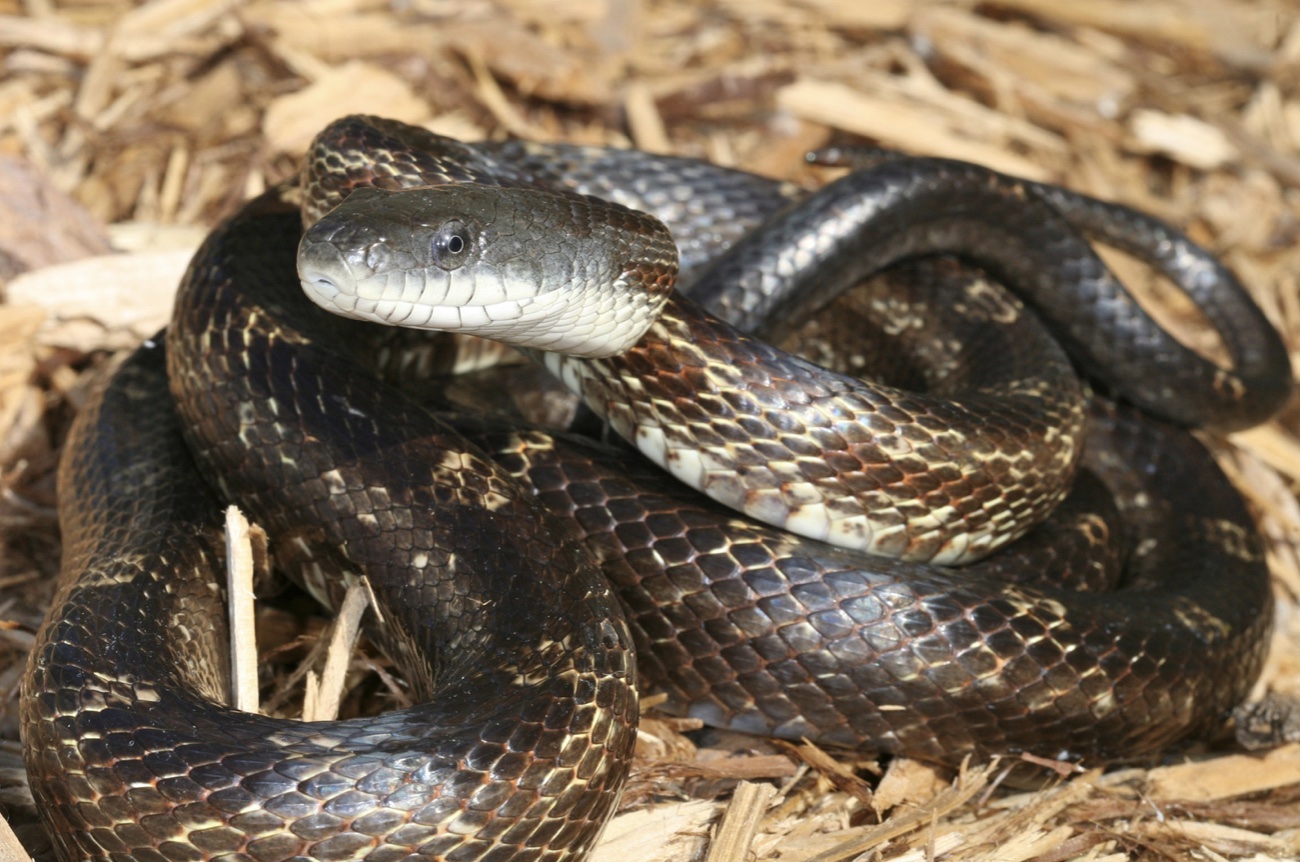
7. Eastern Rat Snake
Pantherophis obsoletus
Fast and big, black Rat Snakes in Virginia can certainly make a person jump back in surprise.
But they’re actually great allies, because they help control rat and mice populations and keep venomous snakes at bay.
Rat Snakes (a.k.a. Black Snakes) can grow to be 8 feet long, and they have thick bodies. Despite their nickname, they can have varying colors and patterns, particularly when they’re still juveniles.
Rat Snakes are constrictors and, despite their utility for pest control, have a bad reputation for visiting chicken coops. For some reason, they just LOVE to eat eggs!
READ MORE: The Best Restaurants in Lexington VA & Natural Bridge VA for Foodies
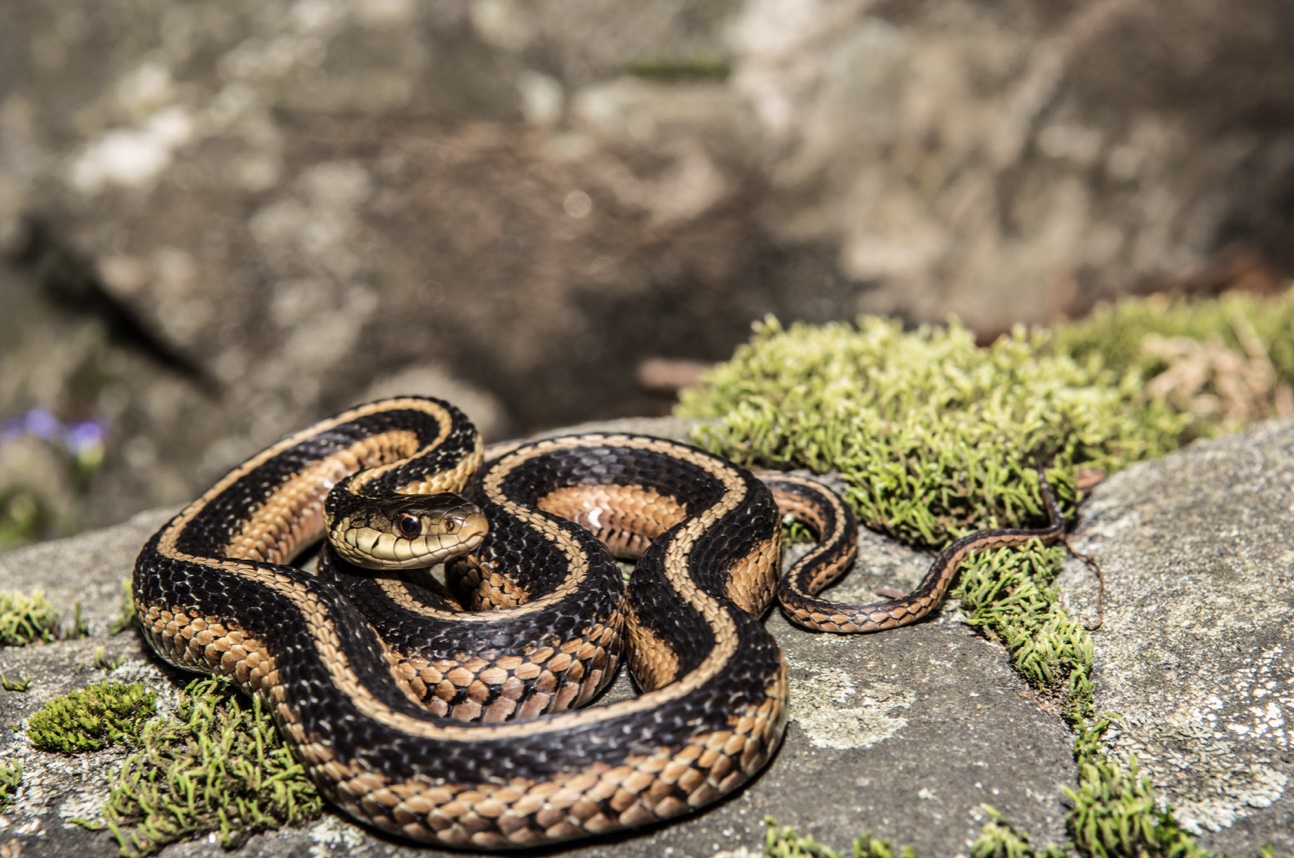
8. Eastern Garter Snake
Thamnophis sirtalis
Garter Snakes are found in just about every state, and they are present throughout the state of Virginia.
They can often be found near water, or even in the garden.
Garter Snakes in Virginia are normally just a few feet long, have thin bodies, and a lot of colorful patterns and stripes.
They have dark patterns on their back, yellow or white stripes down their sides, and their bellies can be green or yellow.
They love to eat lizards and frogs, and are usually in pursuit of them during the day.
READ MORE: The 8 Best Breweries in Roanoke VA, the Heart of Virginia’s Blue Ridge
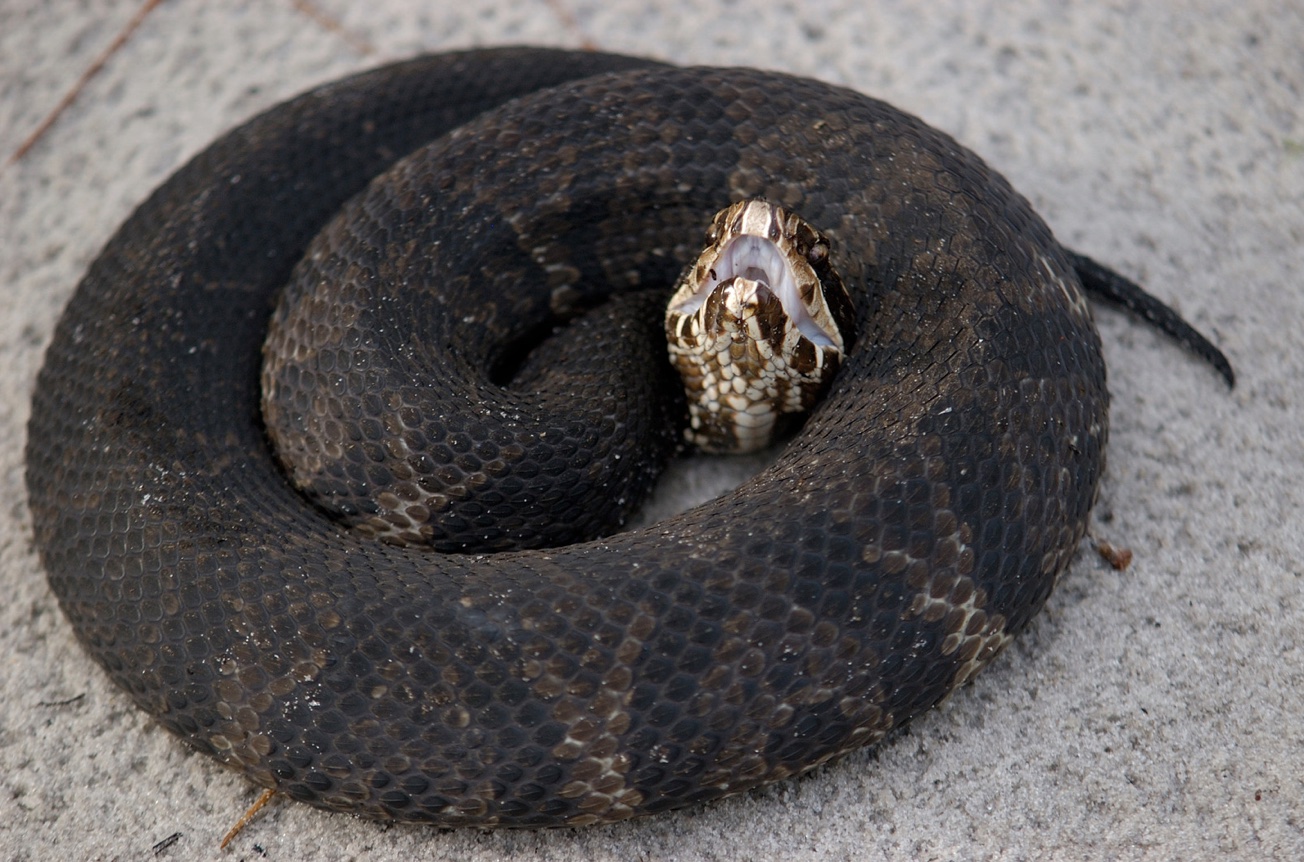
What to Do If You (or Your Dog) Are Bitten by a Snake
It’s important to understand that snake bites are very rare, and venomous snake bites represent only a small fraction.
In a US population of about 330 million, only 7,000-8,000 bites occur annually from venomous snakes. Most of those are dry bites, which have no venom.
The United States averages around 5 fatal snake bites a year, so they’re actually 10 times less common than getting struck and killed by lightning!
If that rare instance does occur, using a tourniquet or sucking out the venom are not good courses of action. In fact, they’re more likely to cause an issue than to solve one. The same can be said for taking Benadryl.
Instead, victims should remain calm, remove any tight-fitting jewelry to accommodate for swelling, and get to the emergency room ASAP.
Another common mistake is attempting to kill or capture an already agitated snake. It’s much better to observe as many distinguishing characteristics as possible from a safe distance.
The same rules apply for dogs and pets that are bitten. More often than not, animals taken directly to the vet do survive snake bites, even from legitimately dangerous snakes. –Jonathon Engels, featured image via Canva


